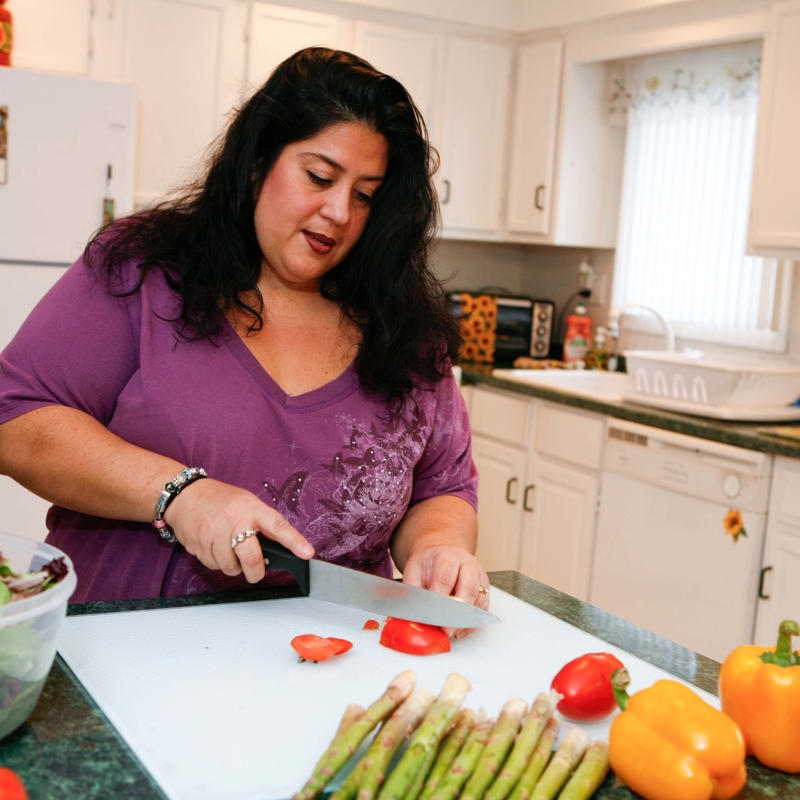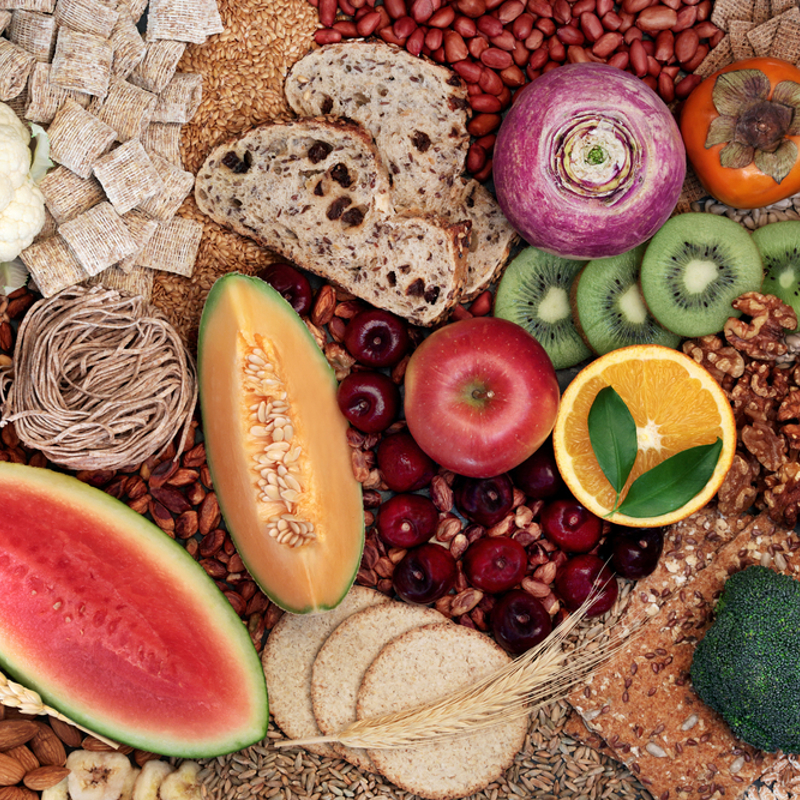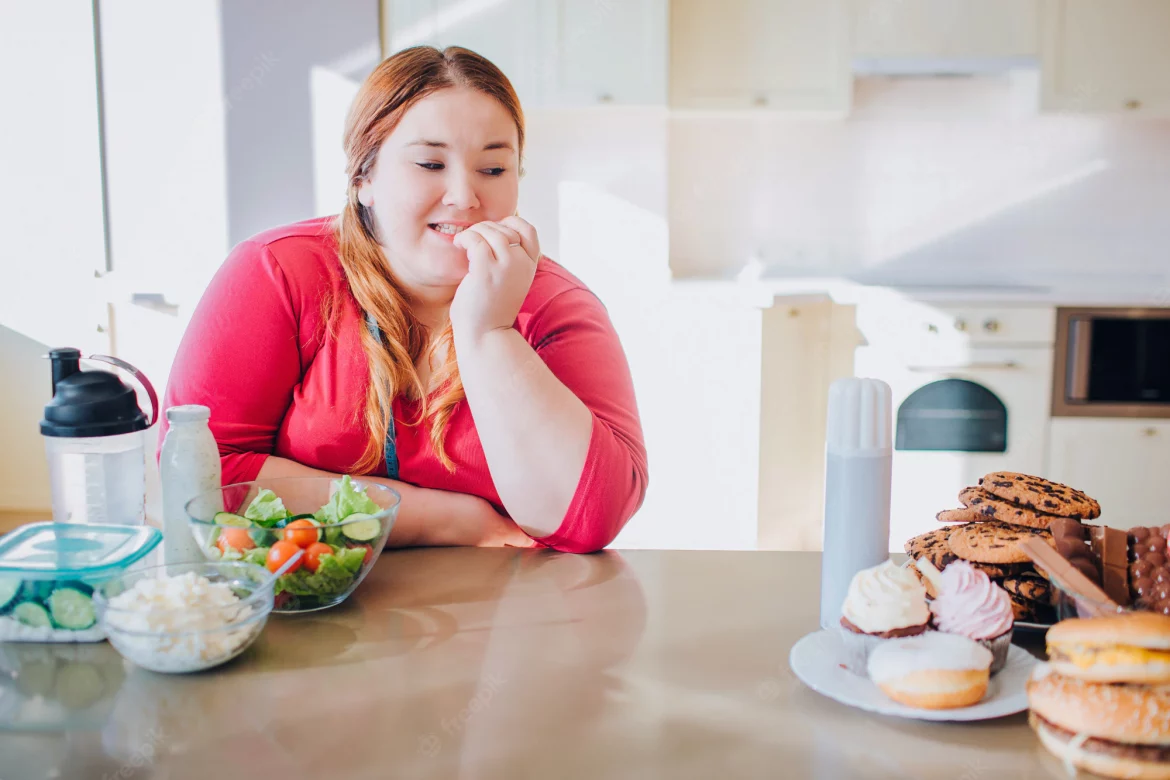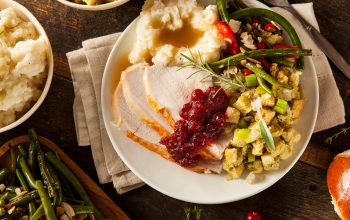Top tips for healthy weight loss:
- To help you find out if you have a healthy bodyweight, measure your body mass index (BMI) and waist circumference.
- To lose weight, the energy you take in from food must be less than the energy you use – eat less, move more!
- Set yourself realistic goals to achieve a healthy weight. Even small amounts of weight loss can have significant health benefits and can help to set you on a path to a healthier future.
- Guidelines recommend that you should try to lose weight gradually, about 1-2lbs (approximately 0.5-1.0kg) a week.
- Different approaches to weight loss will be successful for different individuals, so try to find a weight-loss plan which will work for you.
- Try to make healthy diet and lifestyle changes you can keep, even after you have reached your desired weight, so you do not regain the weight you have lost!

Overweight and obesity
In England, almost 7 in 10 men and 6 in 10 women are overweight or obese, and a quarter of adults are obese. Being overweight or obese increases your risk of developing serious diseases such as type 2 diabetes, coronary heart disease and some cancers.
The risks of developing these diseases increases the more overweight you are. Obesity can also affect your quality of life and lead to psychological problems, such as depression and low self-esteem. Ideally it is better to avoid becoming overweight by eating healthily and exercising regularly and maintaining this throughout life. But problems with weight gain are common so here is some information to help you lose weight sensibly and healthily.
Your bodyweight is determined by the amount of energy obtained from your food compared to the amount of energy that your body is using. The surplus energy you take in from food and drink is stored as fat. To lose weight, the energy you take in from food must be less than the energy you use, in other words eat less and exercise more. There is no ‘quick fix’ for obesity. Weight loss takes time and commitment. However, even losing and keeping off even a small amount of weight (such as 3% of bodyweight if you are obese or about 5% for most people) can produce significant health benefits and reduce your risk of developing obesity-related diseases like type 2 diabetes and heart disease. Losing 5% of your weight means, for example losing 5kg if you weigh 100kg.
Health benefits of losing weight
Weight loss can reduce your risk of heart disease, stroke, type 2 diabetes and some cancers.
It can also reduce the risk of:
- high blood pressure
- angina (heart condition causing chest pain)
- high blood cholesterol levels
- lower back and joint pain
- fertility problems
BMI and waist circumference
To see if you have a healthy weight you can use a measurement called your body mass index, or BMI. This is calculated as follows:
| Your weight in kilograms (kg) divided by your height in metres (m) squared |
So for example, a woman that is 1.60m tall and weighs 60kg would have a BMI of 23.4kg/m2 (The calculation would be: 60 divided by 1.6, and then the answer divided by 1.6 again).
For most adults:
| A BMI between 18.5 and 25 is defined as healthy. A BMI of over 25 is defined as overweight. A BMI of over 30 is defined as obese. |
Waist circumference (size) can also be used to assess your risk of obesity-related diseases (including heart disease, type 2 diabetes and cancer) as these conditions are affected by where your body fat is stored, as well as by your weight. People who are very muscular sometimes have a high BMI without excess fat. For these people, waist circumference may give a better indication of whether they have excess fat. To measure your waist circumference, measure around your middle at a point half-way between your lower rib and top of your hips.
Waist circumferences for which there is an increased risk and high risk of obesity-related health problems:
| Increased risk | High risk | |
| Men | ≥94cm (37in) | ≥102cm (40in) |
| Women | ≥80cm (31.5in) | ≥88 cm (34.5in) |
What’s considered a healthy BMI and waist circumference is also influenced by your ethnic background. If you have an ethnic minority background (such as Asian, African or Afro-Caribbean), the BMI and waist circumference thresholds for being considered overweight or obese may be lower. This is because your ethnicity can affect your risk of developing certain conditions. The International Diabetes Federation and South Asian Health Foundation agree that men from South Asian and Chinese ethnic groups are at increased risk of type 2 diabetes if waist size is greater than 90cm. If you have any questions about your BMI or waist circumference, talk to a health professional like your GP or a dietitian.
Sensible weight loss
Sensible weight loss should be seen as an overall lifestyle change which involves eating a healthy balanced diet and doing plenty of physical activity.
Guidelines recommend that you should try to lose weight gradually, about 1-2 lbs (approximately 0.5-1.0kg) a week. This way, the weight is more likely to stay off. This rate of weight loss is based on using up 600kcal per day more than you take in. On average, this means consuming no more than 1400kcal a day if you are a woman, and no more than 1900 kcal a day if you are a man. The amount of weight you lose will depend on how much weight you need to lose and how active you are.
Different approaches to weight loss will be successful for different individuals, so try to find a weight-loss plan which will work for you. Calorie and portion size control is an important part of a weight loss strategy, but success is likely to depend on how well you can stick to your plan more than whether it’s low carb or low fat.
Your health professional may recommend a very-low-calorie diet if you need to lose weight quickly (for example, if you are going to have joint replacement surgery), but these diets are not typically used for routine weight loss.
Whichever weight loss plan you choose, try to ensure that at the end of the plan you make some long-term healthy diet and lifestyle changes so that you can keep the weight you have lost off.
Eating a healthy, balanced diet and keeping physically active is important during and after you have reached your desired weight.
Things to consider
- It is not advisable to lose weight whilst pregnant.
- Parents/carers of children who are overweight or obese should seek advice from a health professional about what you can do and what support is available in your area.
- If you suffer from any medical condition, you should always ask your GP before starting a weight loss plan.
- It is important to maintain a healthy weight. Weight loss which results in somebody being underweight can also cause health problems. Boys, girls, men and women from all backgrounds and ethnic groups can be affected by eating disorders. If you think you, or somebody you know, may have an eating problem or disorder, help is available.
Dietary tips for healthy weight loss
- Avoid fad diets that recommend unsafe practices, such as going without food for long periods of time or cutting out entire food groups. Sticking to these types of diets in the long run is difficult, meaning the chances of meeting your long-term bodyweight goals may be reduced. If you have type 2 diabetes and are considering a low-carbohydrate diet, speak to a health professional (such as a GP or dietitian).
- Decrease the number of foods and drinks you are consuming that are high in fat or sugars. To do this, you could try limiting sugars-containing drinks, fried foods, cakes, biscuits and desserts in your diet. These should be thought of as occasional treats, eaten in small quantities, rather than everyday occurrences. Try swapping them for healthier alternatives lower in fat and/or sugars.
- You should eat plenty of fruit and vegetables (at least 5 A DAY).
- Boil, steam, grill, poach or microwave food rather than frying. If roasting, use a small amount of an oil high in unsaturated fat (such as olive or rapeseed oil).
- Choose lean cuts of meat, leaner mince and trim off the fat from meat and skin from poultry.
- Eat more beans and pulses, these are good alternatives to meat as they are low in fat and high in fibre and still a good source of protein.
- You should try to opt for ‘reduced fat’ or ‘low fat’ versions of dairy foods such as reduced fat cheese and low-fat yogurt. Switch to a lower fat milk (skimmed, semi-skimmed or 1% milk) if you have not already done so.
- Read the nutrition information on food labels as this will help you choose foods which are lower in fat, sugars and calories. The traffic light colours on the front of product packaging show whether the product has a high (red), medium (amber) or low (green) amount of fat, saturates, sugars and salt. Try to eat more greens and ambers and fewer reds.
- Watch your portion sizes and avoid situations where you know you may be tempted to overeat.
- Base your meals on starchy foods, choosing wholegrain or higher fibre varieties where possible, such as potatoes with skins on, wholemeal bread and wholewheat pasta. But be careful not to add fat to these foods, for example creamy sauces to pasta or butter/fat spreads to potatoes.
- Restrict the frequency and portion size of high energy snacks you eat such as chocolate, cakes and fried crisps.
- Moderate the amount of alcohol you consume. Alcohol has calories too – these count towards your total energy intake each day. For example, a pint of lager has about the same calorie content as a packet of crisps. If you drink alcohol, try alternating your drinks with a glass of water, opt for a lower alcohol beverage, or dilute alcoholic drinks with sparkling water or sugar free mixer.

Physical activity
There is evidence to show that people who combine regular physical activity with a healthy eating plan are more successful at losing weight and keeping it off.
Adults should try to be active daily. Being physically active has many health benefits, including helping to maintain a healthy weight.
| Public Health England recommends at least 150 minutes of moderate-intensity aerobic activity or 75 minutes of vigorous intensity aerobic activity a week (or a combination of both) PLUS Muscle strengthening activities on two days or more of the week |
Moderate intensity physical activity causes you to get warmer and breathe harder and your heart to beat faster (but you should still be able to carry on a conversation). Brisk walking and cycling on level ground are both examples of moderate intensity exercise.
Vigorous activity causes you to breathe hard and fast. If you are working at this level, you won’t be able to say more than a few words without pausing for breath. Running and aerobics are both examples of vigorous exercise.
Physical activity increases the amount of energy you are using, it increases your muscles (lean tissue mass), it helps to maintain your metabolic rate and maintain weight loss. Physical activity also reduces the risk of weight loss reaching a plateau level, which is often seen when people are trying to lose weight. If you are not used to physical activity, you should first aim to gradually build up to 150 minutes of moderate intensity activity per week. As your fitness increases, you can then increase your level of physical activity beyond 150 minutes and start to include more vigorous intensity exercise.
Whatever your size or shape, you should be able to find an activity you enjoy.
This Girl Can is a national campaign developed by Sport England and is a celebration of active women who are doing their thing no matter how well they do it or how they look.
Here are some tips to increase your physical activity:
- Find a type of physical activity you enjoy, this can be anything from walking the dog, dancing, gardening, going to the gym or playing a team sport. The more you enjoy it, the more you are likely to do.
- Exercise with a friend and use each other for motivation.
- Try to make physical activity part of your daily routine, such as walking to work and taking the stairs instead of the lift.
- Do not set yourself unrealistic targets; not everyone will be able to run a marathon!
Here is a guide to how much energy you can use by being physically active. Each person will use a slightly different amount of energy for each activity, depending on things like body size and age. These figures are for an average adult weighing 70kg and doing the activity for 30 minutes.
| Activity | Calories used in 30 minutes (kcal) |
| Brisk walking (3.5mph) | 133 |
| Swimming | 350 |
| Badminton | 158 |
| Cycling (12mph) | 280 |
| Running (6mph) | 350 |
| Park football | 245 |
| Aerobics class | 228 |
| Yoga (hatha) | 88 |
Weight loss support
It has been shown that weight loss plans which provide some form of social support are easier to stick to, compared to those which do not. This could be as simple as having a ‘buddy’ to take part in physical activity with you, joining an online weight-loss community or attending organised weight-loss programme meetings in your area.



